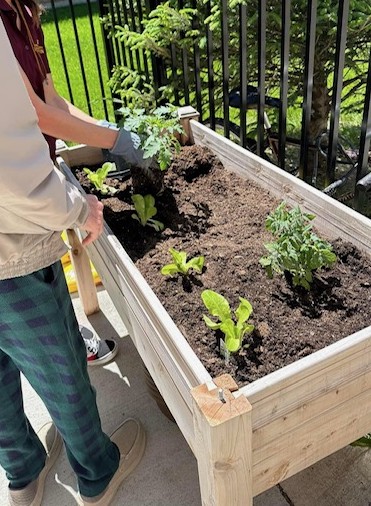Talking Plants
Jillian Patrie | University of Minnesota Yard and Garden Extension
Containers, raised beds and vertical gardening have become popular ways that many urban gardeners grow vegetables and herbs. These gardening methods are perfect for small spaces, such as patios or decks, locations that have poor soil and to navigate mobility or access obstacles. Container and raised bed gardening is very similar to traditional gardening in the ground but does require a few adjustments when it comes to soil, watering and plant selection.
When selecting the size and shape of your raised bed, consider where, who and what the garden is serving. Many gardens may only be a few inches off the ground; others may be designed to accommodate wheelchair access. Raised beds that are closed on the bottom, may need to be a certain depth to accommodate vegetables or other plants with larger root systems. The center of a raised bed should be able to reach from the sides, to avoid walking into the bed to tend plants.
Materials for raised beds can differ, but most are made from wood or metal. Avoid dated pressure treated and railroad ties, as those materials likely contain harmful chemicals. Present day pressure treated wood can be used, as chemical formulas have changed over the years, look for lumber labeled for ground contact use. Many raised beds are also built using galvanized steel instead of wood. Though there is a possibility of zinc leaching into soil, it’s unlikely as Minnesota soils are generally neutral to alkaline, lacking the acidic properties that would cause zinc to degrade. Lining the bed with landscape fabric or other types of liners can help decrease these issues. Bricks, pavers and fabric totes are all other alternative materials used for raised bed construction.
Soil for raised beds should be a mixture of 2/3 to ½ topsoil and ½ to 1/3 plant-based compost (not animal manure). Topsoil can be sourced at local garden centers or through landscaping companies. It is best to avoid topsoil that is very sandy or clay heavy, as these can cause issues with water retention and compaction.
Plant selection can be made to accommodate smaller spaces used for gardening too. Bush type or “space saver” cucumbers are great for container gardening. Determinate tomato varieties will be smaller plants, fitting into tighter spaces. Trellising and utilizing vertical space are another alternative gardening techniques that save space. https://extension.umn.edu/news/vertical-gardening-maximizing-space-minnesota-gardens.
Gardening can be adapted and there are solutions to almost every growing situation. To learn more about raised bed gardening please visit https://extension.umn.edu/planting-and-growing-guides/raised-bed-gardens.
For questions about this article or local assistance please contact Clay County Extension Educator Jill Patrie at 218-299-7338 or by email at patri350@umn.edu.


